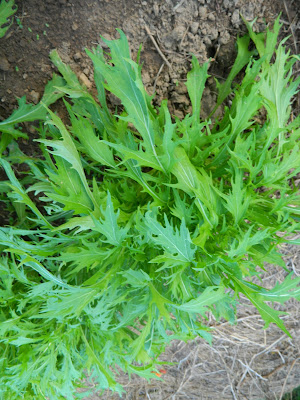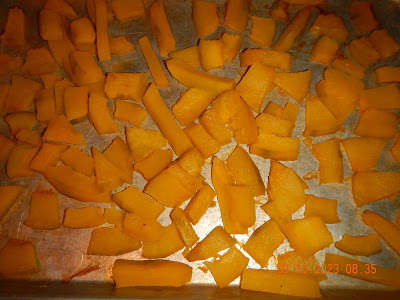Below is the plan for our CSA customers that will be getting their shares in Statesville. (If instead you will be picking up shares at our farm in Yadkinville, see this link.)
CSA OVERVIEW
If you'd be interested in making a weekly commitment to buying a $22
assortment of our vegetables, then our CSA might be for you. In
exchange for the commitment our CSA members make to us, we commit to
growing a full assortment of weekly vegetables for them. Most of the
things we grow for our CSA members are available to our Statesville home delivery customers
as well, but we give our CSA members priority so our CSA members get the
greatest variety of things from our farm.
WHERE AND WHEN
CSA members receive their
shares by taking part in our home delivery program which allows for the option of picking up your share at a drop-off point (normally your house if you live in our delivery area, otherwise probably someone else's house) or meeting us in Statesville at whatever time we make our delivery (which for the farmers market season is on Saturdays at the farmers market.)
WHAT'S
INCLUDED IN CSA SHARES
Our standard $22 CSA shares contain a full assortment of
several dozen different seasonal fresh vegetables (tomatoes,
onions, sweet potatoes, cucumbers, peas, beans, lettuce, okra...),
shitake mushrooms, and other garden and specialty field crops
(like peanuts, strawberries...), all from open-pollinated seed and
grown without chemical pesticides or fertilizers.
Here is a link to photos of sample CSA
shares.
We're glad to pack your share with an assortment of whatever we
think is at its best each week with maximum variety from week to
week. But we also offer the option to marginally customize your
share, depending on what we have available.
CSA COMMITMENT
We expect to be able to offer CSA shares nearly every Saturday
from May to October but also probably one or two weeks in April,
two or three weeks in November, probably one week in December,
maybe one week in March... We'll just let you know in the
newsletter we send out before each drop-off whether CSA shares
will be available to order that week. On the weeks we make
deliveries but don't have CSA shares available, mostly mid-winter,
you are welcome to just order items off from the list, but we
won't fill in or substitute to make a $22 share like we normally would.
In order for us to continue our commitment to each of our CSA
members, we expect our CSA members to order a CSA share at least
85% of the times we offer shares (but if you get at least 25 CSA
shares per year, we'll count that as close enough, even if we make enough
drop-offs that 25 winds up being less than 85% of the total number
of weeks.) So you should expect to spend at least $550.00 with us
if you want to take part in the CSA.
ORDERING
In response to the newsletter we send out announcing a delivery,
you will need to e-mail us back to request a CSA share. If you
have specific requests for what you'd like us to include in your
share, that's also the time to make those requests.
BALANCE AND RECEIPTS
Just as for the home delivery program, you'll keep a balance
with us from which we will deduct your weekly orders. This makes
it straightforward if you would like to order items beyond your
weekly share. For example, you could order a share plus a
bouquet of flowers or plus an additional 20 lbs of sweet
potatoes. We'll simply deduct the amount of your total order from
your balance.
Within a few days of each drop-off we'll send you an e-mail with
(1) the total cost of what you ordered at the last drop-off, (2)
your remaining balance -- if your balance drops below $66, we'll
ask you to go ahead and replenish your balance, (3) the number of
CSA shares you've gotten and the number of weeks we've offered CSA
shares so far that year (so that you can make sure you're ordering
at least 85% of the time, assuming you want to continue receiving
CSA privileges.)
NEW CSA MEMBERS
New members take part in the CSA as trial CSA members. This
gives you a chance to see if the amount and types of food work for
you, if the amount of out-of-town traveling you do is compatible
with the regularity of the CSA, if the drive to pick up your food
(if you live outside our home delivery area) is manageable, etc.
We ask trial CSA members to request CSA shares 11 out of 12
consecutive CSA deliveries. You can begin any week we're offering
CSA shares to regular CSA members.
We invite trial CSA members to order as if they were CSA
members. That means you can request a CSA share any week when
we're offering CSA shares to our regular CSA members, and as with
regular CSA shares we'll fill in whatever portion of the $22 CSA
share for which you don't make requests and we'll make
substitutions for any requests you make that we can't fill,
sometimes including items that weren't part of the list in the
preceding newsletter. The one difference is we'll pack the shares
of our regular CSA members first, so sometimes we may need to
short you and you won't receive the same priority as regular CSA
members.
After you've requested 11 CSA shares (within a period of 12
consecutive CSA deliveries) we'll count you as a regular CSA
member so long as you keep ordering shares at least 85% of the
time.
If during this time you realize the CSA isn't working for
you, you can simply drop back to the home delivery program. This
means you'll just start using your balance just like any home
delivery customer, ordering as much or as little as you want as
often as you want, skipping as many weeks as you want, and you'll
no longer be able to order CSA shares except on the weeks when we
offer sample CSA shares to everyone.
HOW TO PROCEED IF YOU'RE INTERESTED IN JOINING THE CSA
(1) Let us know you're interested in joining the CSA
(2) Plan a visit to the farm. Any of our customers is welcome
to come for a farm visit/tour, but we require a farm visit of new
CSA members. This gives you a chance to better understand what
our farm is all about, what the CSA partnership is about, and what
it means for what you'll be receiving in your CSA shares. It also
helps us better explain the logistics of our system to first time
CSA members and to answer any questions you have.
(3)
Join
the home delivery program (if you're not already a home
delivery customer.) To join the home delivery program, you'll
need to give us a check for at least $150 and commit to spending a
minimum of $150 over the course of the next 12 months -- the first
$150 required for taking part in home deliveries is non-refundable
regardless of whether you decide to continue with the CSA -- but
your first 11 trial CSA shares will add up to more than that, so
you'll need to plan to add to your balance soon into your CSA
trial to continue unless you make a larger initial payment. Any
amount over $150 is fully refundable.
If you have more questions about our CSA, please send us an
e-mail or call us (704-546-5074) or make plans to visit the farm.








































